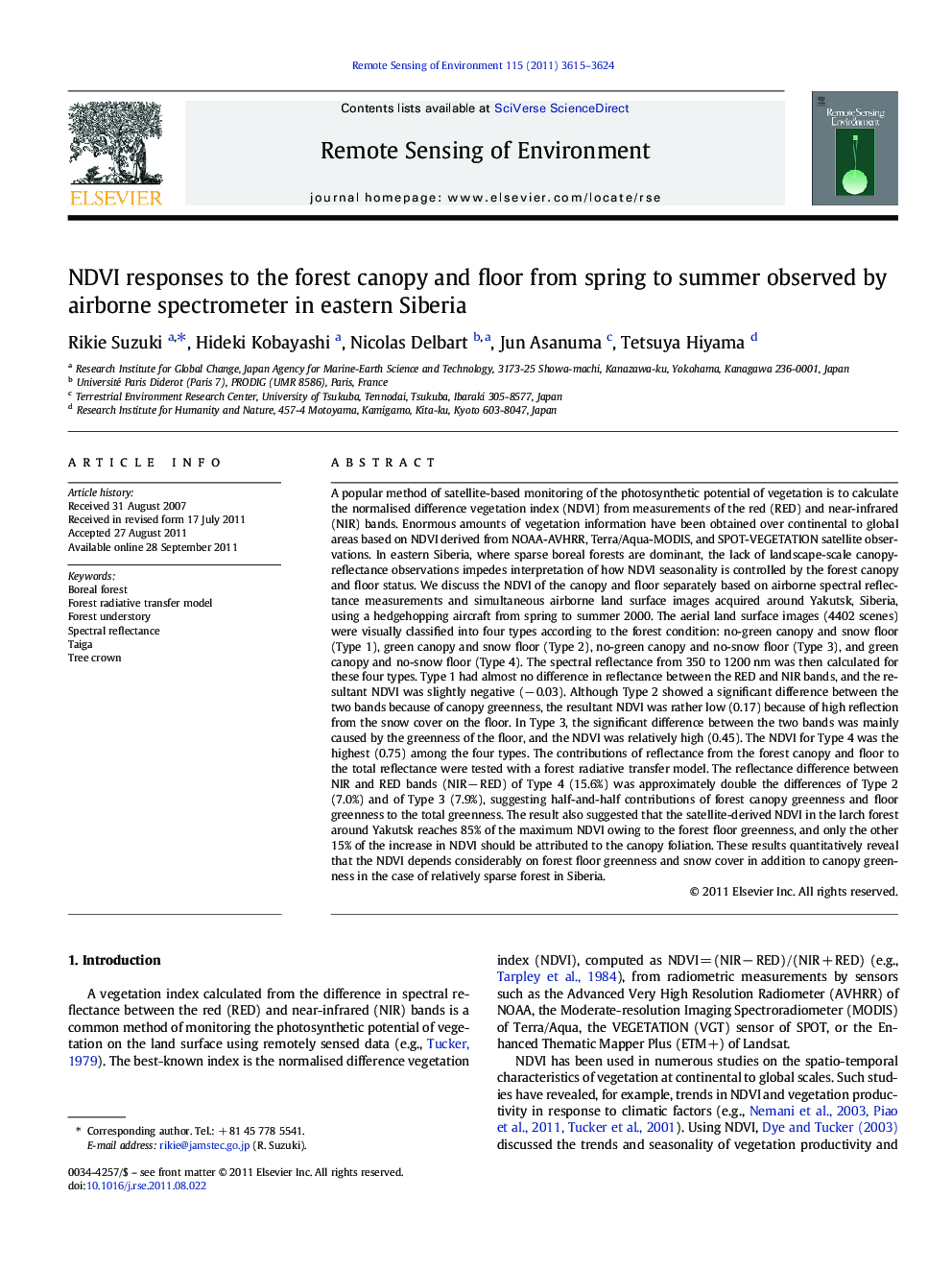| کد مقاله | کد نشریه | سال انتشار | مقاله انگلیسی | نسخه تمام متن |
|---|---|---|---|---|
| 4459504 | 1621285 | 2011 | 10 صفحه PDF | دانلود رایگان |

A popular method of satellite-based monitoring of the photosynthetic potential of vegetation is to calculate the normalised difference vegetation index (NDVI) from measurements of the red (RED) and near-infrared (NIR) bands. Enormous amounts of vegetation information have been obtained over continental to global areas based on NDVI derived from NOAA-AVHRR, Terra/Aqua-MODIS, and SPOT-VEGETATION satellite observations. In eastern Siberia, where sparse boreal forests are dominant, the lack of landscape-scale canopy-reflectance observations impedes interpretation of how NDVI seasonality is controlled by the forest canopy and floor status. We discuss the NDVI of the canopy and floor separately based on airborne spectral reflectance measurements and simultaneous airborne land surface images acquired around Yakutsk, Siberia, using a hedgehopping aircraft from spring to summer 2000. The aerial land surface images (4402 scenes) were visually classified into four types according to the forest condition: no-green canopy and snow floor (Type 1), green canopy and snow floor (Type 2), no-green canopy and no-snow floor (Type 3), and green canopy and no-snow floor (Type 4). The spectral reflectance from 350 to 1200 nm was then calculated for these four types. Type 1 had almost no difference in reflectance between the RED and NIR bands, and the resultant NDVI was slightly negative (− 0.03). Although Type 2 showed a significant difference between the two bands because of canopy greenness, the resultant NDVI was rather low (0.17) because of high reflection from the snow cover on the floor. In Type 3, the significant difference between the two bands was mainly caused by the greenness of the floor, and the NDVI was relatively high (0.45). The NDVI for Type 4 was the highest (0.75) among the four types. The contributions of reflectance from the forest canopy and floor to the total reflectance were tested with a forest radiative transfer model. The reflectance difference between NIR and RED bands (NIR − RED) of Type 4 (15.6%) was approximately double the differences of Type 2 (7.0%) and of Type 3 (7.9%), suggesting half-and-half contributions of forest canopy greenness and floor greenness to the total greenness. The result also suggested that the satellite-derived NDVI in the larch forest around Yakutsk reaches 85% of the maximum NDVI owing to the forest floor greenness, and only the other 15% of the increase in NDVI should be attributed to the canopy foliation. These results quantitatively reveal that the NDVI depends considerably on forest floor greenness and snow cover in addition to canopy greenness in the case of relatively sparse forest in Siberia.
► We identified the forest floor contribution to total greenness of Siberian forest.
► The spectral reflectance was examined by airborne video camera and spectrometer data.
► The result showed a half of the total greenness was attributed to forest floor.
► NDVI reaches 85% of its maximum in early summer by the forest floor greenness only.
► Snow cover on the floor considerably suppresses the NDVI.
Journal: Remote Sensing of Environment - Volume 115, Issue 12, 15 December 2011, Pages 3615–3624